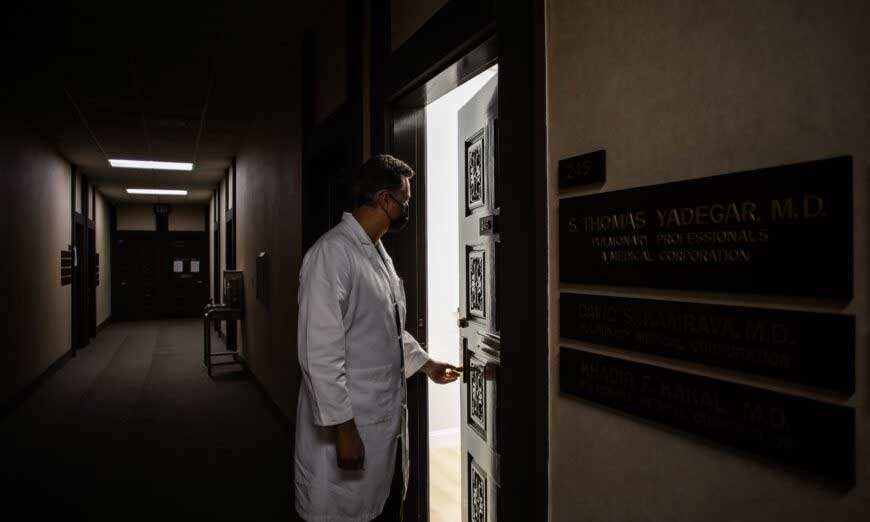
Night shift workers are integral to multiple areas of society; however, people may not be fully aware of the danger that such work pose.
The impact of night work is not only daytime sleepiness, which can increase a person’s risk of road accidents, but also a higher risk of cancer, gastrointestinal issues, obesity, diabetes, and many other negative health consequences.
Sleep Health Foundation Board Member and Senior Sleep Scientist in the Adult Sleep Laboratory at Newcastle’s John Hunter Hospital, Gemma Paech, told The Epoch Times that night shifts are potentially hazardous for people’s health.
“Shift work, in general, has been shown to be associated with a lot of different health problems. So, it could be related to physical health. Shift workers might be more at risk of developing gastrointestinal issues,” Paech said.
“We assume that performance and mental health are impacted by shift work as well.”

Cancer Risk
The World Health Organisation (WHO) has classified night shift work as “probably carcinogenic” because of an increased risk of developing various cancers, including breast, prostate, colon, and rectum.
Paech said that there are two things that happen a lot with shift work that could cause increased cancer risk.
“One is that people might not be getting enough sleep. And then the second one is the time that people are sleeping.”
“Within ourselves, we have a body clock,” Paech said. “For most people, we sleep at nighttime, and we’re awake during the daytime; what happens a lot with shift workers is they have what we call a misalignment between their sleep schedule and what’s going on inside their body.”
She said that within a night shift worker’s body, their body clock is telling them that it’s nighttime when it’s dark, but they’re trying to sleep during the day and be awake at night.
“This creates a lot of problems because then they’re getting signals from the external environment that are out of line with what their internal biology or their body is trying to do,” Paech said.
“This is where some of the cancer risks might come into play. For example, shift workers, we know that they’re eating at different times.”

Impact on Diet
Paech said that night shift workers might consume large meals at night versus people who have a regular day schedule and eat during the daytime, and this can result in a lot of stomach issues.
“They might be having large meals at nighttime versus people who might have a normal day schedule and might be eating during the daytime, and that can cause a lot of issues in your stomach.”
“Your digestion doesn’t work as well or as effectively, and that might lead to other problems. And we sort of know that this disruption can cause the cellular function to change a little bit.”
Paech said that not all of the exact mechanisms of this cellular function are necessarily known. However, she noted that to make it a very simple thing, this disruption between the external environment and what the internal body wants to do is where some of the cancer risk lie.
“Then there’s also the fact that perhaps people working shift work don’t get enough sleep, and that might also contribute to some of those health consequences as well,” she said.
Paech said that because shift work is not going anywhere soon, employers instead need to pay attention to the “rules and recommendations around how many nights someone should be working and how long their rest breaks should be.”
“But it really depends on the industry and what is considered standard within that particular industry. As to what people can do,” she said.
She also noted there is much debate around whether working a continual block of night shifts or rotational shift—for example, a night shift, to an afternoon, to a day shift— is better.

Regulations Around Night Shifts Often Complex
Healthcare is one sector where night shifts are impossible to avoid. As a result, most countries have conditions around the work, but often the regulations are extensive and complex.
In the Australian state of New South Wales, for example, in the 2022 Public Health System Nurses and Midwives State Award provisions around night shifts, which are classified as shifts that begin at or after 4 p.m. and before 6 a.m., state that night shifts can’t last for more than 11 hours, with at least a 10-hour break following the shift, unless otherwise agreed upon by the employee and the local nurse management.
However, the award also provides for night shifts up to 12 and a half hours, and these regulations are more complex. In this case, the worker must have an unpaid meal break that lasts for half an hour and either an hour paid break or two paid half an hour breaks. An employee may also not work more than three consecutive 12-hour shifts, except for once within a 6-week roster cycle, when they may be rostered for four.
Additionally, 12-hour shift work may not be worked in combination with overtime, but no more than half of the shifts within a roster cycle should be night shifts unless otherwise agreed upon by the employees and the nurse management.
Furthermore, a nurse or midwife will not work more than seven consecutive shifts unless the employee requests so themselves. However, no nurse or midwife will work over 10 consecutive shifts. Also, no employee will be rostered on for more than three quick shifts —evening shift followed by morning shift— within a fortnightly pay period unless otherwise agreed upon between the employee and nursing management.
Further Recommendations for Healthcare Shift Work
In 2016, the Expert Reference Group on Work Hours in Healthcare made several recommendations.
The reference group recommended a minimum of 11 hours between shifts, no quick shifts or day-to-night shifts, no more than three consecutive night shifts, and a maximum of 6 consecutive shifts of any type. It was also recommended that healthcare workers be guaranteed one day off a week and that a forward rotation system be employed when scheduling shifts.
A forward rotation system is a strategy that is used to minimise disruption to the circadian rhythm, it involves scheduling an employee’s shifts in a clockwise manner, so a day shift to an evening shift to a night shift.
According to the Institute for Safety, Compensation and Recovery Research (ISCRR) the two shifts that most negatively impact healthcare workers are the evening to day shifts and the first night shift.
Important Notice: This article was originally published at www.theepochtimes.com by Lily Kelly where all credits are due.
Disclaimer
The watching, interacting, and participation of any kind with anything on this page does not constitute or initiate a doctor-patient relationship with Dr. Farrah™. None of the statements here have been evaluated by the Food and Drug Administration (FDA). The products of Dr. Farrah™ are not intended to diagnose, treat, cure, or prevent any disease. The information being provided should only be considered for education and entertainment purposes only. If you feel that anything you see or hear may be of value to you on this page or on any other medium of any kind associated with, showing, or quoting anything relating to Dr. Farrah™ in any way at any time, you are encouraged to and agree to consult with a licensed healthcare professional in your area to discuss it. If you feel that you’re having a healthcare emergency, seek medical attention immediately. The views expressed here are simply either the views and opinions of Dr. Farrah™ or others appearing and are protected under the first amendment.
Dr. Farrah™ is a highly experienced Licensed Medical Doctor certified in evidence-based clinical nutrition, not some enthusiast, formulator, or medium promoting the wild and unrestrained use of nutrition products for health issues without clinical experience and scientific evidence of therapeutic benefit. Dr. Farrah™ has personally and keenly studied everything she recommends, and more importantly, she’s closely observed the reactions and results in a clinical setting countless times over the course of her career involving the treatment of over 150,000 patients.
Dr. Farrah™ promotes evidence-based natural approaches to health, which means integrating her individual scientific and clinical expertise with the best available external clinical evidence from systematic research. By individual clinical expertise, I refer to the proficiency and judgment that individual clinicians acquire through clinical experience and clinical practice.
Dr. Farrah™ does not make any representation or warranties with respect to the accuracy, applicability, fitness, or completeness of any multimedia content provided. Dr. Farrah™ does not warrant the performance, effectiveness, or applicability of any sites listed, linked, or referenced to, in, or by any multimedia content.
To be clear, the multimedia content is not intended to be a substitute for professional medical advice, diagnosis, or treatment. Always seek the advice of your physician or other qualified health providers with any questions you may have regarding a medical condition. Never disregard professional medical advice or delay in seeking it because of something you have read or seen in any website, video, image, or media of any kind. Dr. Farrah™ hereby disclaims any and all liability to any party for any direct, indirect, implied, punitive, special, incidental, or other consequential damages arising directly or indirectly from any use of the content, which is provided as is, and without warranties.








